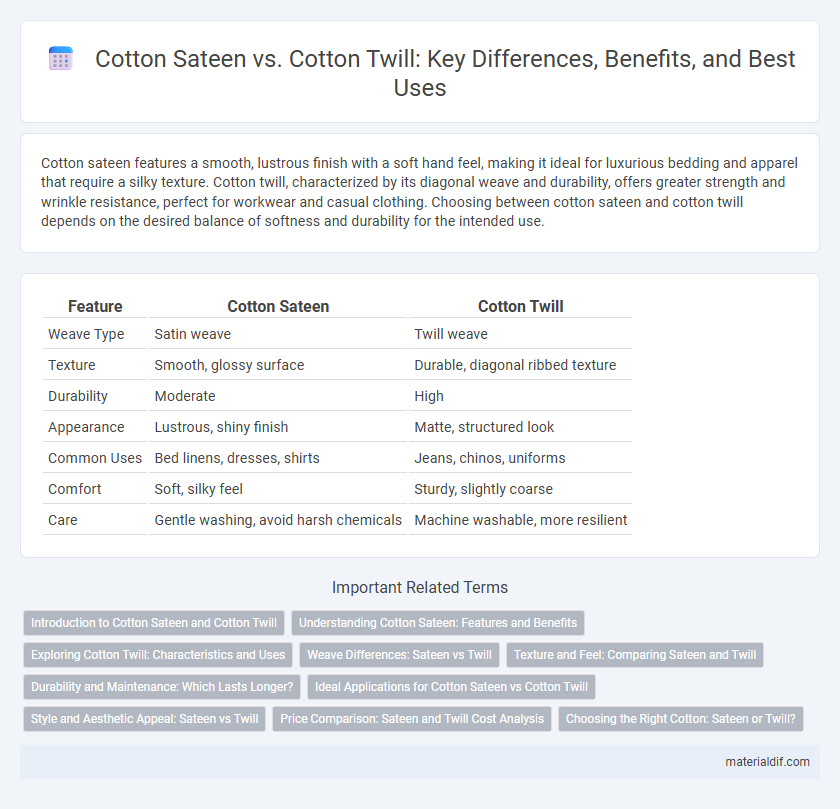Cotton sateen features a smooth, lustrous finish with a soft hand feel, making it ideal for luxurious bedding and apparel that require a silky texture. Cotton twill, characterized by its diagonal weave and durability, offers greater strength and wrinkle resistance, perfect for workwear and casual clothing. Choosing between cotton sateen and cotton twill depends on the desired balance of softness and durability for the intended use.
Table of Comparison
| Feature | Cotton Sateen | Cotton Twill |
|---|---|---|
| Weave Type | Satin weave | Twill weave |
| Texture | Smooth, glossy surface | Durable, diagonal ribbed texture |
| Durability | Moderate | High |
| Appearance | Lustrous, shiny finish | Matte, structured look |
| Common Uses | Bed linens, dresses, shirts | Jeans, chinos, uniforms |
| Comfort | Soft, silky feel | Sturdy, slightly coarse |
| Care | Gentle washing, avoid harsh chemicals | Machine washable, more resilient |
Introduction to Cotton Sateen and Cotton Twill
Cotton sateen features a smooth, lustrous surface created by a satin weave that highlights the fiber's natural sheen, making it ideal for luxurious bedding and apparel. Cotton twill displays a distinctive diagonal rib pattern formed by its weave, offering durability and a textured appearance commonly used in workwear and denim. Both fabrics derive from cotton fibers but differ significantly in weave structure, finish, and typical applications.
Understanding Cotton Sateen: Features and Benefits
Cotton sateen features a smooth, lustrous surface achieved through a satin weave that highlights the fiber's natural sheen and softness, making it ideal for luxurious bedding and apparel. Its dense weave enhances durability while maintaining a silky feel and excellent drape, setting it apart from the more textured and rugged cotton twill. The fabric's breathability and moisture-wicking properties provide comfort in various climates, combining aesthetic appeal with practical benefits.
Exploring Cotton Twill: Characteristics and Uses
Cotton twill is distinguished by its diagonal weave pattern, providing enhanced durability and resistance to wrinkles compared to other cotton fabrics. Commonly used in workwear, denim, and upholstery, its dense weave offers a sturdy yet breathable material ideal for heavy-duty applications. The fabric's texture and strength make it suitable for items requiring longevity and comfort, such as trousers, jackets, and home textiles.
Weave Differences: Sateen vs Twill
Cotton sateen features a smooth, lustrous surface created by a satin weave that floats the warp threads, producing a soft and silky texture ideal for luxury bedding and apparel. Cotton twill uses a diagonal weave pattern characterized by the interlacing of weft threads over multiple warp threads, resulting in a durable, textured fabric often used for workwear and denim. The key weave difference lies in sateen's emphasis on surface sheen and softness versus twill's strength and distinctive diagonal ribbing.
Texture and Feel: Comparing Sateen and Twill
Cotton sateen features a smooth, lustrous surface with a soft and silky feel due to its satin weave, making it ideal for luxurious bedding and garments. Cotton twill exhibits a distinctive diagonal weave that creates a durable, textured surface with a slightly rougher feel, offering enhanced strength and wrinkle resistance. The tactile difference between sateen's sleek finish and twill's structured texture impacts their suitability for different clothing and home textile applications.
Durability and Maintenance: Which Lasts Longer?
Cotton twill is known for its superior durability due to its diagonal weave, which provides greater resistance to wear and tear compared to cotton sateen's smooth, satin-like finish. Twill fabrics tend to withstand frequent washing and heavy use without significant deterioration, making them ideal for workwear and upholstery. In contrast, cotton sateen requires more delicate maintenance to preserve its luster and can show signs of wear more quickly under rigorous conditions.
Ideal Applications for Cotton Sateen vs Cotton Twill
Cotton sateen, with its smooth, lustrous finish and soft hand, is ideal for luxurious bedding, elegant apparel, and decorative home textiles where a silky appearance is desired. Cotton twill, characterized by its durable diagonal weave and heavier weight, suits workwear, denim, upholstery, and casual garments that require strength and resistance to wear. Select cotton sateen for comfort and sheen, while choosing cotton twill for ruggedness and durability in high-traffic applications.
Style and Aesthetic Appeal: Sateen vs Twill
Cotton sateen features a smooth, lustrous finish with a subtle sheen that enhances its elegant and luxurious appearance, making it ideal for refined, stylish clothing and sophisticated home textiles. Cotton twill offers a durable, textured surface with distinctive diagonal ribbing, delivering a more casual, rugged aesthetic suitable for workwear and everyday apparel. The sateen's soft drape contrasts with twill's structured form, impacting the overall style and visual appeal of garments crafted from these fabrics.
Price Comparison: Sateen and Twill Cost Analysis
Cotton sateen typically commands a higher price than cotton twill due to its smooth, lustrous finish and more complex weaving process. Cotton twill is generally more affordable, favored for its durability and ease of production, making it a cost-effective option for everyday garments. The price difference reflects variations in texture, finishing techniques, and market demand, influencing consumer choice based on budget and fabric characteristics.
Choosing the Right Cotton: Sateen or Twill?
Cotton sateen offers a smooth, lustrous finish with a soft hand feel, making it ideal for luxurious bedding and apparel requiring a polished look. Cotton twill features a distinctive diagonal weave, providing enhanced durability and wrinkle resistance, perfect for workwear and casual garments. Choosing between cotton sateen and twill depends on the desired texture, durability, and end-use application, with sateen favoring softness and sheen, while twill emphasizes strength and structure.
Cotton Sateen vs Cotton Twill Infographic

 materialdif.com
materialdif.com